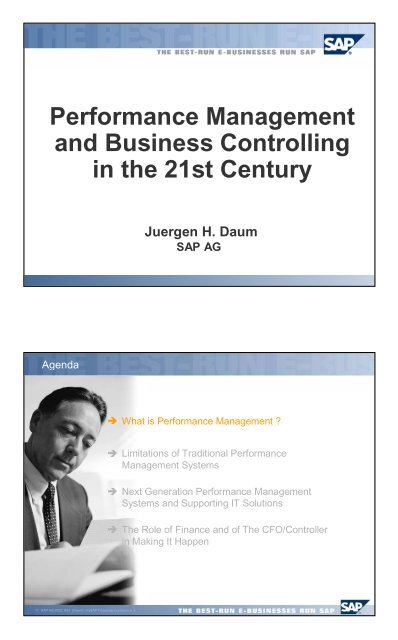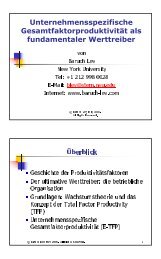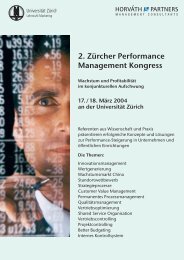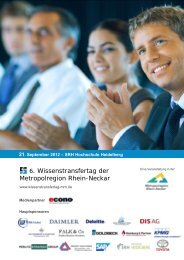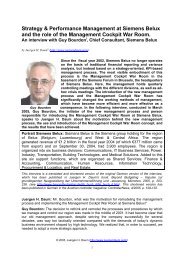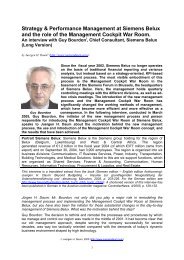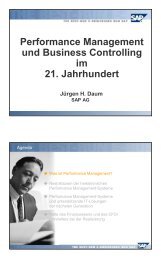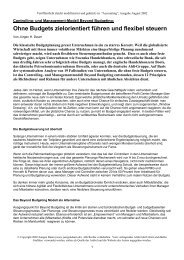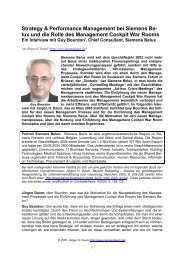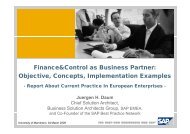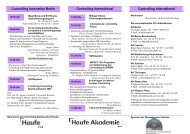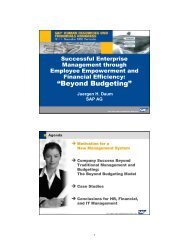Performance Management and Business ... - Juergen Daum
Performance Management and Business ... - Juergen Daum
Performance Management and Business ... - Juergen Daum
Create successful ePaper yourself
Turn your PDF publications into a flip-book with our unique Google optimized e-Paper software.
<strong>Performance</strong> <strong>Management</strong><br />
<strong>and</strong> <strong>Business</strong> Controlling<br />
in the 21st Century<br />
<strong>Juergen</strong> H. <strong>Daum</strong><br />
SAP AG<br />
Agenda<br />
Î What is <strong>Performance</strong> <strong>Management</strong> ?<br />
Î Limitations of Traditional <strong>Performance</strong><br />
<strong>Management</strong> Systems<br />
Î Next Generation <strong>Performance</strong> <strong>Management</strong><br />
Systems <strong>and</strong> Supporting IT Solutions<br />
Î The Role of Finance <strong>and</strong> of The CFO/Controller<br />
in Making It Happen<br />
© SAP AG 2002, A02 (<strong>Daum</strong>) mySAP Financials Conference 2
What is <strong>Performance</strong> <strong>Management</strong> ?<br />
Managing the “Black Box“<br />
Input<br />
The Enterprise<br />
The Company<br />
The <strong>Business</strong> Unit<br />
The Profit Center ...<br />
Measuring Results<br />
Output<br />
Output<br />
- Input<br />
=Result<br />
© SAP AG 2002, A02 (<strong>Daum</strong>) mySAP Financials Conference 3<br />
The Evolution of <strong>Performance</strong> <strong>Management</strong> Systems<br />
Type of Economy<br />
Value Creation-<br />
Model/Processes<br />
<strong>Management</strong>/<br />
Controlling Tools<br />
International Trade,<br />
16th-18th Century<br />
(Example: Fugger)<br />
Enterprise<br />
Value creation through<br />
legally binding external transactions<br />
Double Entry<br />
Accounting,<br />
General Ledger<br />
Industrial<br />
Mass Production,<br />
19th-20th Century<br />
(Example: Ford)<br />
Knowledge <strong>and</strong><br />
Service Economy,<br />
21st Century<br />
(Example: Cisco,<br />
SAP)<br />
Manufacturing<br />
Enterprise<br />
Value creation through<br />
complex internal mass manufacturing<br />
processes<br />
Customers<br />
Innovation<br />
“Extended“ Enterprise Partners<br />
Value creation through<br />
systematic innovation <strong>and</strong> relationship<br />
building with customers <strong>and</strong> partners<br />
General Ledger<br />
+<br />
Cost Accounting<br />
General Ledger<br />
+<br />
Cost Accounting<br />
+<br />
??<br />
© SAP AG 2002, A02 (<strong>Daum</strong>) mySAP Financials Conference 4
Agenda<br />
Î What is <strong>Performance</strong> <strong>Management</strong> ?<br />
Î Limitations of Traditional <strong>Performance</strong><br />
<strong>Management</strong> Systems<br />
Î Next Generation <strong>Performance</strong> <strong>Management</strong><br />
Systems <strong>and</strong> Supporting IT Solutions<br />
Î The Role of Finance <strong>and</strong> of The CFO/Controller<br />
in Making It Happen<br />
© SAP AG 2002, A02 (<strong>Daum</strong>) mySAP Financials Conference 5<br />
Reasons for the limitations of Traditional<br />
<strong>Performance</strong><br />
<strong>Management</strong> Systems<br />
1. Changing economics<br />
New value drivers/changing corporate operation models<br />
2. Changing enterprise structures:<br />
<strong>Performance</strong> management of “ecosystems“/“business process networks“<br />
3. Changing corporate governance philosophy<br />
Outside-in enterprise/stakeholder orientation<br />
© SAP AG 2002, A02 (<strong>Daum</strong>) mySAP Financials Conference 6
Changing Corporate Value Drivers<br />
38%<br />
16%<br />
Tangible<br />
Assets<br />
Market<br />
Value<br />
62%<br />
84%<br />
Intangible<br />
Assets<br />
62%<br />
38%<br />
1982<br />
1992<br />
1999<br />
New Value Drivers*:<br />
z Investments in systematic innovation<br />
(Knowledge/intellectual capital-based)<br />
z Investments in relationship building<br />
z Investments in organizational capital<br />
* Activities which generate a return above cost of capital<br />
© SAP AG 2002, A02 (<strong>Daum</strong>) mySAP Financials Conference 7<br />
Changing Economics<br />
“<br />
20 years ago we had the tools that were needed to manage strategy<br />
based on tangible assets. The management toolbox was filled with<br />
financial tools that were designed to manage tangible things.<br />
Now we have a different world. Strategy <strong>and</strong> value is being created<br />
from intangible assets. We need a new toolbox for management.<br />
Organizations underst<strong>and</strong> strategy <strong>and</strong> how to compete in the new<br />
economy. But they do not have the management tools that allow<br />
them to do this. As a result we find that 7 out of 10 organizations<br />
fail to execute their strategy.<br />
David P. Norton,<br />
“<br />
co-author of the Balanced Scorecard concept*<br />
*Interview with David Norton from the book: <strong>Juergen</strong> H. <strong>Daum</strong>, Intangible Assets <strong>and</strong> Value Creation, p. 234<br />
© SAP AG 2002, A02 (<strong>Daum</strong>) mySAP Financials Conference 8
New Value Drivers Are Triggering Change in Corporate Operation<br />
Models<br />
Traditional Industrial<br />
Operations Model<br />
New Operations Model<br />
PLM<br />
Manufacturing<br />
Procurement<br />
Sales<br />
Customer<br />
Supplier<br />
SRM<br />
SCM<br />
CRM<br />
Customer<br />
z Time dimension: Month, Quarter<br />
z More direct relation between input <strong>and</strong> output<br />
z Resources can be acquired <strong>and</strong> deployed short term<br />
<strong>Management</strong> Tools:<br />
- P&L / Financial Reporting<br />
- Cost Accounting<br />
z Time dimension: Quarter, 1-2 years, 3-5 years<br />
z More indirect relation between input <strong>and</strong> output<br />
z Major resources have to be developed in-house<br />
<strong>Management</strong> Tools:<br />
?<br />
© SAP AG 2002, A02 (<strong>Daum</strong>) mySAP Financials Conference 9<br />
As a result of the more complex value delivery systems, strategy is<br />
playing a more important role<br />
Partner Network<br />
(Service Partner)<br />
HumanCapital<br />
(Skilled sales &<br />
R&D staff)<br />
Organizational<br />
Capital<br />
(R&D Processes)<br />
Improved<br />
Customer<br />
Relations<br />
Competitive<br />
Products<br />
Market Share<br />
Financial Capital<br />
(Revenue, Cash Flow)<br />
Role of strategy: Bundling tangible <strong>and</strong><br />
intangible assets <strong>and</strong> processes <strong>and</strong> activities<br />
around these assets in order to create value<br />
© SAP AG 2002, A02 (<strong>Daum</strong>) mySAP Financials Conference 10
Strategy has to be adapted continuously<br />
Strategy has to be continuously adapted to changing market conditions<br />
in order to preserve the company’s value creation potential:<br />
Adapt Strategy<br />
Planning/<br />
Simulation<br />
Communication<br />
STRATEGY<br />
Feedback<br />
Execute<br />
© SAP AG 2002, A02 (<strong>Daum</strong>) mySAP Financials Conference 11<br />
Reasons for the limitations of Traditional<br />
<strong>Performance</strong><br />
<strong>Management</strong> Systems<br />
1. Changing economics<br />
New value drivers/changing corporate operation models<br />
2. Changing enterprise structures:<br />
<strong>Performance</strong> management of “ecosystems“/“business process networks“<br />
3. Changing corporate governance philosophy<br />
Outside-in enterprise/stakeholder orientation<br />
© SAP AG 2002, A02 (<strong>Daum</strong>) mySAP Financials Conference 12
Changing Enterprise Models <strong>and</strong> Structures:<br />
“<br />
The real structural changes ... are the alliances <strong>and</strong> partnerships.<br />
They are creating a “different climate“. They create a different<br />
economy <strong>and</strong> require different management. They change, for<br />
instance, what we mean by “leadership“. For in these new<br />
alliances, partnerships, <strong>and</strong> co-existences, nobody comm<strong>and</strong>s.<br />
Making these new structures perform <strong>and</strong> work is a good deal<br />
more difficult than making the traditional comm<strong>and</strong> structure<br />
based on ownership <strong>and</strong> control work. But where they do work,<br />
they produce superior performance <strong>and</strong> results.<br />
Peter F. Drucker*<br />
“<br />
*Peter F. Drucker, “The Real Meaning of the Merger Boom”, The Conference Board 1999 Annual Essay <strong>and</strong> Report, 1999, p. 6.<br />
© SAP AG 2002, A02 (<strong>Daum</strong>) mySAP Financials Conference 13<br />
Changing Enterprise Models <strong>and</strong> Structures:<br />
90s:<br />
Global Enterprise<br />
Tomorow:<br />
Global Ecosystem<br />
of Partners<br />
Functions or Countries / Regions<br />
Product or <strong>Business</strong> Units<br />
„ Provide performance information for the extended enterprise<br />
„ Collaborative performance management processes required<br />
„ Higher flexibility required for (re-)configuring performance management systems<br />
© SAP AG 2002, A02 (<strong>Daum</strong>) mySAP Financials Conference 14
Reasons for the limitations of Traditional<br />
<strong>Performance</strong><br />
<strong>Management</strong> Systems<br />
1. Changing economics<br />
New value drivers/changing corporate operation models<br />
2. Changing enterprise structures:<br />
<strong>Performance</strong> management of “ecosystems“/“business process networks“<br />
3. Changing corporate governance philosophy<br />
Ooutside-in enterprise/stakeholder orientation<br />
© SAP AG 2002, A02 (<strong>Daum</strong>) mySAP Financials Conference 15<br />
Changing Corporate Governance Philosophy<br />
“<br />
In today’s post-cold war world, trade, commerce <strong>and</strong> technology<br />
have reconfigured the global balance of power equation.<br />
Market forces <strong>and</strong> large corporations in many ways have a bigger<br />
impact on people’s lives than government or regional <strong>and</strong><br />
international institutions. Against that backdrop we need to widen<br />
the focus of business <strong>and</strong> embrace a new civic role for large<br />
corporations, globally <strong>and</strong> locally<br />
Göran Lindahl,<br />
former CEO ABB Group*<br />
“<br />
* Göran Lindahl, “A New Role for Global <strong>Business</strong>es”, Time Magazine Europe, January 31, 2000<br />
© SAP AG 2002, A02 (<strong>Daum</strong>) mySAP Financials Conference 16
The Changing Corporate Governance Philosophy<br />
Employees<br />
Investors<br />
Society<br />
z<br />
Active<br />
z<br />
Mobility<br />
z<br />
Punish underperformers<br />
z Scarcity of talent<br />
Customers<br />
Enterprise Inc.<br />
z<br />
z<br />
New perception of<br />
corporate responsibility<br />
New influence groups<br />
(NGOs)<br />
Partners<br />
z<br />
Less loyal<br />
z<br />
No company is able to work<br />
without partners anymore<br />
© SAP AG 2002, A02 (<strong>Daum</strong>) mySAP Financials Conference 17<br />
The Changing Corporate Governance Philosophy<br />
Examples:<br />
z Sustainable Development /<br />
Triple Bottom Line Reporting<br />
z Corporate Social<br />
Responsibility (CSR)<br />
movement<br />
z Global Reporting Initiative<br />
(www.globalreporting.com)<br />
The Shell Report:<br />
“triple bottom line“<br />
reporting about:<br />
z Economic,<br />
z Environmental,<br />
z Social performance<br />
„ Balancing different strategic objectives<br />
„ Consider stakeholder objectives in internal decision making<br />
„ Engage stakeholders <strong>and</strong> improve relationships with them<br />
© SAP AG 2002, A02 (<strong>Daum</strong>) mySAP Financials Conference 18
Impact on The <strong>Performance</strong> <strong>Management</strong> System<br />
z Extending the scope: The new management system has to reflect the<br />
business system <strong>and</strong> its value drivers. It therefore has to include<br />
financial <strong>and</strong> non-financial performance indicators <strong>and</strong> has to span the<br />
extended enterprise<br />
z Balancing long term value creation with short term performance<br />
management <strong>and</strong> continuous business optimization: Integration of<br />
strategic <strong>and</strong> operational control through strategic, enterprise<br />
performance <strong>and</strong> operational management processes<br />
z Outside-in approach: The growing importance of external relationships<br />
for enterprise success require a target management system based on<br />
external benchmarks rather than on internal management objectives<br />
z Continuous change becomes the st<strong>and</strong>ard: Requires more<br />
transparency of risks <strong>and</strong> opportunities <strong>and</strong> continuous optimization of<br />
investment decisions <strong>and</strong> strategy<br />
z Adaptablity becomes a success factor: No fixed budgets but flexible<br />
plans <strong>and</strong> flexible resource utilization based on rolling collaborative<br />
forecasts<br />
© SAP AG 2002, A02 (<strong>Daum</strong>) mySAP Financials Conference 19<br />
Agenda<br />
Î What is <strong>Performance</strong> <strong>Management</strong> ?<br />
Î Limitations of Traditional <strong>Performance</strong><br />
<strong>Management</strong> Systems<br />
Î Next Generation <strong>Performance</strong> <strong>Management</strong><br />
Systems <strong>and</strong> Supporting IT Solutions<br />
Î The Role of Finance <strong>and</strong> of The CFO/Controller<br />
in Making It Happen<br />
© SAP AG 2002, A02 (<strong>Daum</strong>) mySAP Financials Conference 20
“<br />
Investors need a variety of information to project future profits<br />
<strong>and</strong> cash flow. Historical financial results are a starting point, but<br />
are rarely adequate by themselves. Investors need to underst<strong>and</strong><br />
the company’s business model, the market for its products, the<br />
specific tangible <strong>and</strong> intangible assets that provide its<br />
competitive edge, <strong>and</strong> the quality of its management team. They<br />
also need to underst<strong>and</strong> the key milestones for the development<br />
of the company <strong>and</strong> its progress on achieving key operating<br />
performance measures.<br />
an SEC Taskforce *<br />
Managers need the same information in order to be able to deliver on<br />
investor’s expectations. Changes in external disclosure of corporations<br />
require changes in the internal performance management system first.<br />
“<br />
* an SEC Taskforce: “Strengthening Financial Markets: Do Investors have the Information they need ?, New York, 2001, p. 4.<br />
The article can be downloaded at http://www.fei.org/finrep/files/SEC-Taskforce-Final-6-6-2k1.pdf<br />
© SAP AG 2002, A02 (<strong>Daum</strong>) mySAP Financials Conference 21<br />
Next Generation <strong>Performance</strong> <strong>Management</strong> Systems<br />
Enterprise<br />
<strong>Management</strong> System<br />
Strategic Goals/<br />
Strategic Change <strong>Management</strong><br />
Short Term Goals/<br />
Enterprise <strong>Performance</strong> <strong>Management</strong><br />
Operational <strong>Management</strong> Systems<br />
PLM<br />
Supplier<br />
SRM<br />
SCM<br />
CRM<br />
Customer<br />
HR FIN IT …<br />
Resources<br />
© SAP AG 2002, A02 (<strong>Daum</strong>) mySAP Financials Conference 22
Elements of The New Enterprise <strong>Management</strong> System<br />
Extended Strategic<br />
Measurement System<br />
Integrated<br />
<strong>Management</strong> Processes<br />
Create value <strong>and</strong> long term competitive<br />
advantage<br />
Adapt strategy<br />
Target Setting<br />
Strategy <strong>Management</strong><br />
Process<br />
Strategic<br />
Analysis<br />
Forecasting<br />
Enabling a “balanced“ view of all<br />
strategic success factors<br />
Measure<br />
<strong>Performance</strong><br />
<strong>Performance</strong> <strong>Management</strong><br />
Process<br />
Adjust<br />
operations<br />
Decide<br />
how to adapt<br />
Meet short term performance targets <strong>and</strong><br />
realize created value<br />
Integrated management processes<br />
enable linking of strategy to operations<br />
<strong>and</strong> day-to-day business<br />
© SAP AG 2002, A02 (<strong>Daum</strong>) mySAP Financials Conference 23<br />
Next Generation <strong>Performance</strong> <strong>Management</strong> Systems<br />
Enterprise<br />
<strong>Management</strong> System<br />
Strategic Goals/<br />
Strategic Change <strong>Management</strong><br />
Short Term Goals/<br />
Enterprise <strong>Performance</strong> <strong>Management</strong><br />
Operational <strong>Management</strong> Systems<br />
PLM<br />
Supplier<br />
SRM<br />
SCM<br />
CRM<br />
Customer<br />
HR FIN IT …<br />
Resources<br />
© SAP AG 2002, A02 (<strong>Daum</strong>) mySAP Financials Conference 24
Elements of The New Operational <strong>Management</strong> System<br />
Comprehensive Operational<br />
Measurement System<br />
Strategic Learning<br />
<strong>and</strong> Feedback<br />
Integrated Operational<br />
<strong>Management</strong> Processes<br />
Prototyping<br />
Go Decision<br />
Implementation<br />
Technological<br />
Research<br />
Product-Lifecycle<br />
<strong>Management</strong><br />
Market Research<br />
<strong>Business</strong><br />
Development<br />
Test & Release<br />
SCM<br />
Analytics<br />
PLM<br />
Analytics<br />
CRM<br />
Analytics<br />
Purchase Plan<br />
SCM<br />
Source<br />
Make<br />
Dem<strong>and</strong><br />
Planning<br />
Deliver<br />
Engage<br />
Lead<br />
Close<br />
Generation<br />
CRM<br />
Implement Service<br />
HR<br />
Analytics<br />
Financial<br />
Analytics<br />
Informs about all relevant value<br />
creation processes (actual<br />
performance, forecasts,<br />
opportunities <strong>and</strong> risks)<br />
Support Processes/<strong>Management</strong> of Resources<br />
HR IT Alliances Finance<br />
Integrated management processes<br />
enable coordination of activities <strong>and</strong><br />
better forecasting for optimized resource<br />
dem<strong>and</strong> planning<br />
© SAP AG 2002, A02 (<strong>Daum</strong>) mySAP Financials Conference 25<br />
Conflicting Economics of Enterprise Sub-Ecosystems<br />
Example: SAP AG<br />
Development<br />
Field<br />
z Market share<br />
z Analyst<br />
ratings<br />
z Sales revenue<br />
z Customer satisfaction<br />
© SAP AG 2002, A02 (<strong>Daum</strong>) mySAP Financials Conference 26
One Common KPI-Based “Truth” <strong>and</strong> Integrated <strong>Management</strong><br />
Processes as The Main Building Blocks<br />
Strategy <strong>and</strong><br />
Enterprise <strong>Performance</strong><br />
<strong>Management</strong> System<br />
External<br />
communication<br />
Strategic<br />
Planning<br />
Strategy <strong>Management</strong> Process<br />
<strong>Performance</strong> <strong>Management</strong><br />
Process<br />
KPIs/Measures as<br />
“communication basis”<br />
for management processes<br />
Product Lifecycle <strong>Management</strong><br />
Supply Chain<br />
<strong>Management</strong><br />
Customer<br />
Relationship<br />
<strong>Management</strong><br />
<strong>Business</strong><br />
Execution System<br />
Support Processes (HR, FIN, IT …)<br />
© SAP AG 2002, A02 (<strong>Daum</strong>) mySAP Financials Conference 27<br />
The Tableau de Bord: A conceptional framework for a comprehensive<br />
performance meassurement system<br />
Balanced Scorecard<br />
Strategy <strong>and</strong> Corporate<br />
<strong>Performance</strong><br />
Markets /<br />
Customers<br />
Financial Results<br />
Processes /<br />
Resources<br />
Strategic<br />
Projects<br />
Value Chain Scoreboard<br />
Product Innovation<br />
Discovery<br />
Implementation<br />
Commerzialisation<br />
Operations Cockpits<br />
Operations<br />
Supply Chain<br />
Cockpit<br />
Customer<br />
Relationship<br />
<strong>Management</strong><br />
Cockpit<br />
Basis Resources<br />
Resource <strong>Management</strong> Cockpits<br />
Human<br />
Resources<br />
Information<br />
Technology<br />
Alliances<br />
Finance<br />
Source <strong>and</strong> copyright: <strong>Juergen</strong> <strong>Daum</strong>, Intangible Assets <strong>and</strong> Value Creation, Wiley, 2002<br />
© SAP AG 2002, A02 (<strong>Daum</strong>) mySAP Financials Conference 28
The Evolution of <strong>Management</strong> Systems<br />
Level of<br />
Enterprise<br />
<strong>Management</strong><br />
Excellence<br />
Dialog-based<br />
Planning-/<br />
Forecastingbased<br />
Reporting-based<br />
The <strong>Management</strong> Cockpit: A concept for improved<br />
interaction <strong>and</strong> communication within management or<br />
project teams<br />
Time<br />
Time<br />
© SAP AG 2002, A02 (<strong>Daum</strong>) mySAP Financials Conference 29<br />
A Dialog Based <strong>Management</strong> Systems Help Companies to Move<br />
Beyond Budgeting<br />
Dialog-based<br />
<strong>Management</strong><br />
Processes<br />
Facts about<br />
the past<br />
z Create a common picture of<br />
opportunities <strong>and</strong> possible futures<br />
z Agree on actions to shape the future<br />
z Communicate with stakeholders<br />
Opinions about<br />
potentials for<br />
the future<br />
<strong>Management</strong> processes are supported by instruments such as:<br />
Rolling forecasting, Scenario planning, Systems thinking<br />
© SAP AG 2002, A02 (<strong>Daum</strong>) mySAP Financials Conference 30
IT Implications<br />
What kind of IT support does the<br />
new performance management approach require ?<br />
© SAP AG 2002, A02 (<strong>Daum</strong>) mySAP Financials Conference 31<br />
IS Requirements to Support <strong>Performance</strong> <strong>Management</strong> Concepts<br />
Beyond Budgeting<br />
z Flexible KPI based measurement system that provides managers with timely<br />
<strong>and</strong> relevant information <strong>and</strong> decision support<br />
Î Data Warehouse, Analytics, Fast Close/<strong>Business</strong> Activity Monitoring<br />
z Flexible resource planning, forecasting <strong>and</strong> monitoring processes require a<br />
system, that spans the organization<br />
Î Planning system <strong>and</strong> forecasting system decoupled from operational<br />
systems (e.g. based on a Data Warehouse)<br />
z Flexible IT infrastructure that is able to easily integrate various systems,<br />
provide flexibility to change processes, enables user centric access <strong>and</strong><br />
services without lousing the necessary integration<br />
ÎOpen <strong>and</strong> flexible IS infrastructure for accounting, analytics, management<br />
process support <strong>and</strong> user interaction<br />
© SAP AG 2002, A02 (<strong>Daum</strong>) mySAP Financials Conference 32
<strong>Management</strong> Information Delivery Architecture<br />
Operations<br />
<strong>Business</strong> Accounting<br />
Analytic World<br />
System 1<br />
(inhouse)<br />
Analytics 1<br />
System 2<br />
(inhouse)<br />
System 3<br />
(partner)<br />
“Accounting<br />
Engine”<br />
Data Warehousing<br />
Analytics 2<br />
Analytics 3<br />
Portals<br />
System 4<br />
(partner)<br />
z Process-oriented<br />
flexibility<br />
z Free of accounting<br />
semantics<br />
z Virtual/fast close<br />
through high<br />
automation level<br />
z Consistency, parallel<br />
views<br />
z User-oriented<br />
flexibility<br />
z Optimized for<br />
analysis <strong>and</strong><br />
decision support<br />
© SAP AG 2002, A02 (<strong>Daum</strong>) mySAP Financials Conference 33<br />
A Reporting <strong>and</strong> Information System That Is Optimized for<br />
Analytics <strong>and</strong> Decision Support<br />
Web-based<br />
portals<br />
Strategic<br />
Enterprise <strong>Management</strong><br />
<strong>Business</strong> Analytics<br />
• Model-based world,<br />
multidimensional OLAP<br />
data structures<br />
Data Warehouse/OLAP Server<br />
• Cross-component<br />
data integration<br />
• Shared business<br />
functions<br />
© SAP AG 2002, A02 (<strong>Daum</strong>) mySAP Financials Conference 34
Integrated Strategic Enterprise <strong>Management</strong> Process<br />
Adapt<br />
Objectives<br />
Strategic<br />
Planning<br />
Breakdown<br />
targets<br />
<strong>Performance</strong><br />
Database<br />
Reporting /<br />
Analysis<br />
Plan <strong>and</strong><br />
Execute<br />
© SAP AG 2002, A02 (<strong>Daum</strong>) mySAP Financials Conference 35<br />
Decision Support<br />
SAP SEM<br />
MC Room with<br />
“Flight Deck”<br />
SAP<br />
BW<br />
Web-based portal<br />
© SAP AG 2002, A02 (<strong>Daum</strong>) mySAP Financials Conference 36
From Strategy <strong>and</strong> Enterprise <strong>Performance</strong> <strong>Management</strong> to<br />
<strong>Business</strong> Optimization<br />
Strategic Enterprise <strong>Management</strong><br />
Strategy<br />
<strong>Management</strong><br />
<strong>Performance</strong><br />
Measurement<br />
<strong>Business</strong><br />
Planning &<br />
Simulation<br />
<strong>Business</strong><br />
Consolidation<br />
Stakeholder<br />
Relationship<br />
<strong>Management</strong><br />
„ Manage strategies to create long term value<br />
„ Manage performance to improve short term results<br />
<strong>Business</strong> Analytics<br />
Financial/<br />
PLM<br />
BU Analytics<br />
CRM<br />
Analytics<br />
SCM<br />
Analytics<br />
HR<br />
Analytics<br />
Financial<br />
PLM<br />
Analytics<br />
„ Optimize operational efficiency across functions<br />
to improve overall business performance<br />
Transactional<br />
Systems<br />
© SAP AG 2002, A02 (<strong>Daum</strong>) mySAP Financials Conference 37<br />
<strong>Business</strong> Analytics Example: Optimize the Product Innovation<br />
Chain<br />
Balanced<br />
Scorecard<br />
SEM: Manage <strong>and</strong> Monitor Overall <strong>Performance</strong><br />
Monitor <strong>Business</strong><br />
<strong>Performance</strong>:<br />
z EVA, Profit<br />
z Customer Value<br />
z Process Efficiency<br />
z Strategy<br />
Implementation<br />
<strong>Management</strong><br />
Cockpit<br />
Analyze Product<br />
Innovation Chain:<br />
z R&D Efficiency<br />
z Innovation<br />
Revenues<br />
z R&D Pipeline<br />
Value<br />
<strong>Business</strong> Analytics: Optimize the Product Innovation Chain<br />
HR Analytics: Workforce<br />
Skill Optimization<br />
PLM Analytics: R&D<br />
CRM Analytics: Market &<br />
Portfolio Optimization<br />
Dem<strong>and</strong> Analysis<br />
Optimize product development effectiveness<br />
Financial Analytics:<br />
R&D Cost <strong>Management</strong><br />
CRM Analytics:<br />
<strong>Business</strong> Development<br />
Financial Analytics:<br />
Product Profitability & CF<br />
Optimize product development <strong>and</strong> commercialization efficiency<br />
Discovery<br />
Evaluation<br />
Product<br />
<strong>Business</strong><br />
Prototyping<br />
Development Development<br />
Product Innovation Process<br />
Sales &<br />
Marketing<br />
© SAP AG 2002, A02 (<strong>Daum</strong>) mySAP Financials Conference 38
A Framework for Integrated Strategic <strong>and</strong> Operational Planning<br />
<strong>and</strong> Forecasting<br />
Portfolio <strong>Management</strong><br />
Capital Market Interpreter<br />
• Market Portfolio<br />
• Shareholder Value<br />
• Technology Portfolio • Value Gap Analysis<br />
...<br />
• Sensitive Analysis<br />
Integrated Financial Statements<br />
P&L<br />
Cash Flow Balance Sheet<br />
• Net Revenue • Indirect/Direct • Increase of<br />
Method<br />
Fixed Assets<br />
• COGS<br />
• Overheads<br />
• Cash Flow operating,<br />
invest., finance activities<br />
Profitability Plan<br />
Cost Center Plan<br />
Investment Plan<br />
• Net Revenue<br />
• COGS<br />
• Promotional Exp.<br />
• Promotional Exp.<br />
• Overheads<br />
• Investment<br />
Budget<br />
...<br />
• Overheads<br />
Sales Plan<br />
Headcount Plan<br />
IT Cost Plan<br />
• Sales volume<br />
• New Employee<br />
• New Hardware<br />
• Discount<br />
• Salary<br />
• Maintenance<br />
...<br />
© SAP AG 2002, A02 (<strong>Daum</strong>) mySAP Financials Conference 39<br />
Forecasting Process<br />
3. Update Plans<br />
2. Forecasting<br />
1. Simulation<br />
BW<br />
Infocubes<br />
© SAP AG 2002, A02 (<strong>Daum</strong>) mySAP Financials Conference 40
Analytical Cost <strong>Management</strong><br />
Strategy <strong>and</strong> Enterprise<br />
<strong>Management</strong><br />
Balanced Scorecard<br />
Analytical Cost <strong>Management</strong><br />
<strong>Business</strong> Analytics<br />
Resources<br />
Activities<br />
Cost Objects<br />
(Customers,<br />
Products, ...)<br />
<strong>Business</strong> Information Warehouse<br />
Operational Systems<br />
R/3 SCM CRM<br />
© SAP AG 2002, A02 (<strong>Daum</strong>) mySAP Financials Conference 41<br />
Stakeholder Relationship <strong>Management</strong><br />
„ Investors<br />
„ Other Stakeholders<br />
Communication with Stakeholders/Stakeholder Relationship <strong>Management</strong><br />
Analyze own<br />
potential <strong>and</strong><br />
stakeholder<br />
expectations<br />
Simulate + decide<br />
value creating<br />
business strategy<br />
Define targets<br />
for BUs/<br />
investments<br />
Manage<br />
performance<br />
<strong>Business</strong> Information<br />
Warehouse<br />
External Sources<br />
© SAP AG 2002, A02 (<strong>Daum</strong>) mySAP Financials Conference 42<br />
Internal Sources<br />
Non-<br />
SAP
<strong>Management</strong> Information Delivery Architecture<br />
Operations<br />
<strong>Business</strong> Accounting<br />
Shared Master <strong>and</strong> Meta Data/Shared Functions<br />
Analytic World<br />
System 1<br />
(inhouse)<br />
Analytics 1<br />
System 2<br />
(inhouse)<br />
System 3<br />
(partner)<br />
“Accounting<br />
Engine”<br />
Data Warehousing<br />
Analytics 2<br />
Analytics 3<br />
Partner<br />
Portals<br />
System 4<br />
(partner)<br />
Integration tools:<br />
z Web-based portals (user-centric)<br />
z Exchange infrastructure (process-centric)<br />
© SAP AG 2002, A02 (<strong>Daum</strong>) mySAP Financials Conference 43<br />
Portal Infrastructure – User-Centric Integration<br />
© SAP AG 2002, A02 (<strong>Daum</strong>) mySAP Financials Conference 44
Exchange Infrastructure – Process-Centric Integration<br />
<strong>Business</strong> processes<br />
Internal<br />
System 1<br />
Internal<br />
System 2<br />
Internal<br />
System 3<br />
Partner<br />
System 1<br />
Partner<br />
System 2<br />
Integration<br />
Server<br />
Integration<br />
Directory<br />
Integration<br />
Repository<br />
© SAP AG 2002, A02 (<strong>Daum</strong>) mySAP Financials Conference 45<br />
mySAP Technology – Web Services Architecture<br />
Portal<br />
Infrastructure<br />
User-centric collaboration<br />
SAP Web<br />
Application Server<br />
Web services<br />
J2EE & ABAP<br />
mySAP CRM<br />
mySAP SCM<br />
mySAP SRM<br />
mySAP PLM<br />
SAP R/3 Enterprise<br />
Legacy ...<br />
Third-party ...<br />
External ...<br />
Exchange<br />
Infrastructure<br />
Process-centric collaboration<br />
mySAP Technology<br />
© SAP AG 2002, A02 (<strong>Daum</strong>) mySAP Financials Conference 46
Agenda<br />
Î What is <strong>Performance</strong> <strong>Management</strong> ?<br />
Î Limitations of Traditional <strong>Performance</strong><br />
<strong>Management</strong> Systems<br />
Î Next Generation <strong>Performance</strong> <strong>Management</strong><br />
Systems <strong>and</strong> Supporting IT Solutions<br />
Î The Role of Finance <strong>and</strong> of The CFO/Controller<br />
in Making It Happen<br />
© SAP AG 2002, A02 (<strong>Daum</strong>) mySAP Financials Conference 47<br />
Organizational Vision: Virtual Finance<br />
80s 90s Tomorrow<br />
“Shift”<br />
“Rift”<br />
CFO<br />
Decision support<br />
<strong>and</strong> stakeholder<br />
information self<br />
services<br />
Coordination,<br />
consulting, finance<br />
as “<strong>Business</strong> Unit”<br />
Decision Support<br />
Specialist Finance Services<br />
Transaction Processing<br />
Transaction<br />
processing<br />
through shared<br />
service center<br />
Outsourced<br />
specialist finance<br />
services<br />
„ Self Services<br />
„ Centralization<br />
„ Outsourcing<br />
„ Collaboration<br />
© SAP AG 2002, A02 (<strong>Daum</strong>) mySAP Financials Conference 48
Step 1: Corporate Finance Self Services<br />
Self Services for “customers“<br />
Alerts/<br />
“push”<br />
reports<br />
Interactive<br />
analysis<br />
on<br />
dem<strong>and</strong><br />
z Accounting/consolidation<br />
z Budgeting/forecasting<br />
z Capital investment planning<br />
z Cash management/treasury<br />
Financial<br />
backend<br />
services<br />
z Information preparation<br />
z Creation of new reports<br />
z Content management<br />
z ….<br />
Self services for<br />
contributors<br />
Operative units<br />
© SAP AG 2002, A02 (<strong>Daum</strong>) mySAP Financials Conference 49<br />
Step 2: Central <strong>Business</strong> Intelligence Competence Center<br />
Transfer of<br />
economic<br />
knowledge<br />
(e.g. workshops)<br />
Special services<br />
e.g.commercial<br />
due diligence<br />
in M&A<br />
Manager<br />
Portal<br />
Services offered<br />
Investor<br />
Portal<br />
Individual<br />
investor<br />
relationship<br />
management<br />
<strong>Management</strong><br />
consulting<br />
internally &<br />
for partners<br />
BI Competence Center<br />
(interdisciplinary team)<br />
Tasks executed<br />
Monitoring the<br />
economics in<br />
the company’s<br />
value creation<br />
system<br />
External &<br />
internal<br />
information/<br />
data<br />
gathering<br />
Editing &<br />
publication of<br />
important<br />
business<br />
information<br />
Keeping the<br />
management<br />
system<br />
conceptually<br />
up-to-date<br />
© SAP AG 2002, A02 (<strong>Daum</strong>) mySAP Financials Conference 50
Step 3: Shared Collaborative <strong>Business</strong> Intelligence Competence Center<br />
Manager<br />
Portal<br />
Stakeholder<br />
Portal<br />
<strong>Business</strong> Intelligence Services<br />
Auditor<br />
portal<br />
Other<br />
Services<br />
Consultant<br />
portal<br />
Accounting Services<br />
Collaborative Costing/<br />
Controlling Services<br />
Audit/tax<br />
service<br />
providers<br />
Partner<br />
1<br />
Partner<br />
2<br />
Partner<br />
3<br />
Partner<br />
4<br />
Professional<br />
services providers<br />
Partner Operations<br />
© SAP AG 2002, A02 (<strong>Daum</strong>) mySAP Financials Conference 51<br />
The Transition Route – Major Success Factors<br />
z Identify the problem areas with the current performance<br />
management system (e.g. via a survey) <strong>and</strong> actively sell the case<br />
for change <strong>and</strong> a vision for a new system to senior management<br />
z Look for quick wins (by providing fast actuals, by improving<br />
access to information, by moving to continuous rolling forecasting,<br />
by introducing KPIs …) - start small, be fast<br />
z Set up a cross-functional, interdisciplinary team to steer <strong>and</strong><br />
manage the implementation project – it can serve later as the core<br />
group of the new <strong>Business</strong> Intelligence Competence Center<br />
© SAP AG 2002, A02 (<strong>Daum</strong>) mySAP Financials Conference 52
“<br />
“I used to believe that changing the culture was the<br />
first action that had to be achieved, but on reflection<br />
everything I’ve seen over the past decade tells me<br />
it’s wrong... Culture changes only after you have<br />
altered people’s actions, after the new behavior<br />
produces some group benefit for a period of time,<br />
<strong>and</strong> after people see the connection between the<br />
new actions <strong>and</strong> the performance improvement.”<br />
John Kotter*<br />
“<br />
John Kotter: Leading Change, Harvard <strong>Business</strong> School Press Boston, 1996, pp156<br />
© SAP AG 2002, A02 (<strong>Daum</strong>) mySAP Financials Conference 53<br />
Book Tip<br />
Intangible Assets <strong>and</strong> Value Creation<br />
by <strong>Juergen</strong> H. <strong>Daum</strong><br />
German edition now available, Galileo Press, ISBN 3-89842-112-0, April 2002<br />
English edition forthcoming (publisher: John Wiley); planned for summer 2002<br />
Including interviews with<br />
z David Norton<br />
z Leif Edvinsson<br />
z Baruch Lev<br />
<strong>and</strong> other leading experts<br />
More information about the book at:<br />
www.juergendaum.com/mybook.htm (English)<br />
www.juergendaum.de/mybook_d.htm (deutsch)<br />
Contact the author: jhd@juergendaum.de<br />
© SAP AG 2002, A02 (<strong>Daum</strong>) mySAP Financials Conference 54
Copyright 2002 SAP AG. All Rights Reserved<br />
„ No part of this publication may be reproduced or transmitted in any form or for any purpose without the express<br />
permission of SAP AG. The information contained herein may be changed without prior notice.<br />
„ Some software products marketed by SAP AG <strong>and</strong> its distributors contain proprietary software components of other<br />
software vendors.<br />
„ Microsoft®, WINDOWS®, NT®, EXCEL®, Word®, PowerPoint® <strong>and</strong> SQL Server® are registered trademarks of<br />
Microsoft Corporation.<br />
„ IBM®, DB2®, DB2 Universal Database, OS/2®, Parallel Sysplex®, MVS/ESA, AIX®, S/390®, AS/400®, OS/390®,<br />
OS/400®, iSeries, pSeries, xSeries, zSeries, z/OS, AFP, Intelligent Miner, WebSphere®, Netfinity®, Tivoli®, Informix<br />
<strong>and</strong> Informix® Dynamic ServerTM are trademarks of IBM Corporation in USA <strong>and</strong>/or other countries.<br />
„ ORACLE® is a registered trademark of ORACLE Corporation.<br />
„ UNIX®, X/Open®, OSF/1®, <strong>and</strong> Motif® are registered trademarks of the Open Group.<br />
„ Citrix®, the Citrix logo, ICA®, Program Neighborhood®, MetaFrame®, WinFrame®, VideoFrame®, MultiWin® <strong>and</strong><br />
other Citrix product names referenced herein are trademarks of Citrix Systems, Inc.<br />
„ HTML, DHTML, XML, XHTML are trademarks or registered trademarks of W3C®, World Wide Web Consortium,<br />
Massachusetts Institute of Technology.<br />
„ JAVA® is a registered trademark of Sun Microsystems, Inc.<br />
„ JAVASCRIPT® is a registered trademark of Sun Microsystems, Inc., used under license for technology invented <strong>and</strong><br />
implemented by Netscape.<br />
„ MarketSet <strong>and</strong> Enterprise Buyer are jointly owned trademarks of SAP Markets <strong>and</strong> Commerce One.<br />
„ SAP, SAP Logo, R/2, R/3, mySAP, mySAP.com <strong>and</strong> other SAP products <strong>and</strong> services mentioned herein as well as<br />
their respective logos are trademarks or registered trademarks of SAP AG in Germany <strong>and</strong> in several other countries<br />
all over the world. All other product <strong>and</strong> service names mentioned are trademarks of their respective companies.<br />
© SAP AG 2002, A02 (<strong>Daum</strong>) mySAP Financials Conference 55


